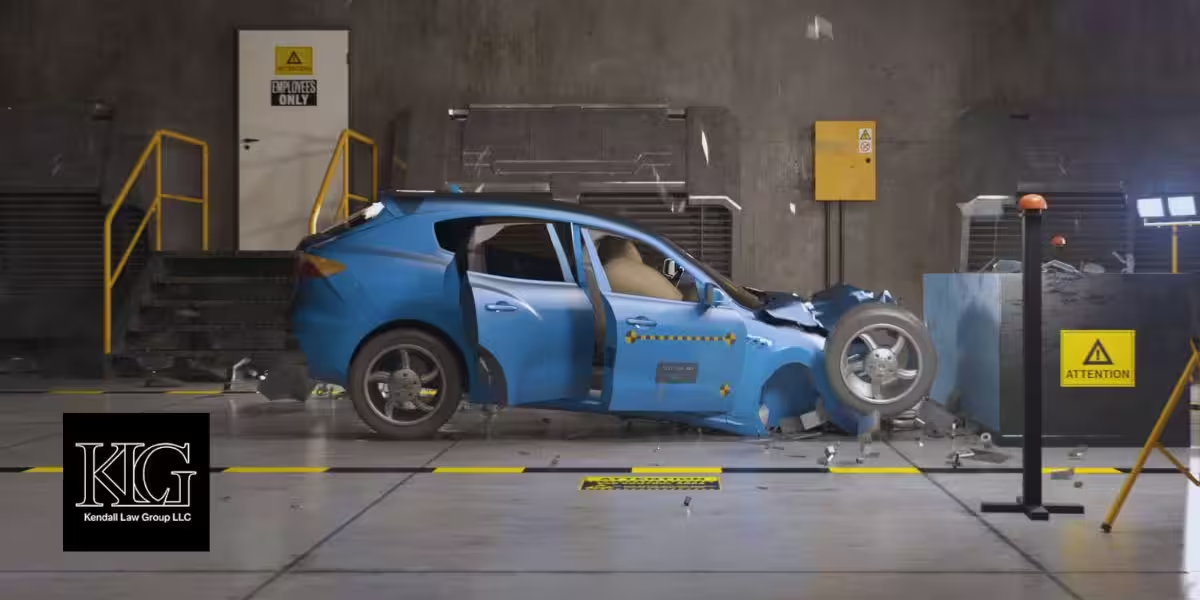
Uncovering the Hidden Dangers of Large SUVs: Important Safety Insights for Kansas City Drivers
A recent article by Consumer Reports covered the Insurance Institute for Highway Safety’s (IIHS) latest findings from crash tests of the three most popular SUVs on the market with its updated moderate frontal overlap crash test, revealing deficits in providing good crash protection for second-row occupants. As Kansas City Auto Accident Injury Trial Lawyers, we prioritize the safety and well-being of our community.
Understanding these new findings is critical for making informed vehicle choices. This blog delves into the latest IIHS ratings, the safety deficits of large SUVs, and why these insights are crucial for Kansas City drivers.
IIHS Safety Ratings: What You Need to Know
The Insurance Institute for Highway Safety (IIHS) is a non-profit organization dedicated to reducing the frequency and severity of motor vehicle crashes. The IIHS evaluates vehicles based on rigorous safety criteria, awarding top ratings to those that excel in protecting occupants and preventing accidents. In 2024, the IIHS introduced updated criteria for their TOP SAFETY PICK and TOP SAFETY PICK+ awards, reflecting the latest advancements in vehicle safety technology and design.
Key Updates to IIHS Safety Criteria
The 2024 IIHS safety ratings introduce several notable changes aimed at enhancing vehicle safety standards. These updates include:
- Enhanced Crashworthiness Tests: The IIHS has intensified its crashworthiness tests, focusing on real-world crash scenarios. These tests assess a vehicle’s ability to protect occupants during frontal, side, rear, and rollover crashes.
- Advanced Driver Assistance Systems (ADAS): Vehicles equipped with advanced driver assistance systems, such as automatic emergency braking (AEB), lane departure warning, and adaptive cruise control, are now crucial factors in achieving top safety ratings.
- Pedestrian Protection: Given the rising number of pedestrian accidents, the IIHS has included pedestrian protection in its evaluation criteria. Vehicles must demonstrate effective AEB systems that can detect and mitigate collisions with pedestrians.
- Headlight Performance: Proper illumination is critical for night driving safety. The IIHS evaluates headlight performance to ensure vehicles provide adequate visibility without causing glare for other drivers.
Top Performers in the 2024 IIHS Safety Ratings
The 2024 TOP SAFETY PICK and TOP SAFETY PICK+ awards highlight vehicles that have excelled in the updated IIHS evaluations. These vehicles offer superior protection for occupants and pedestrians, as well as advanced safety features that help prevent accidents. Some of the top performers include:
- Sedans: Models like the Honda Accord, Toyota Camry, and Subaru Legacy have consistently received high marks for their crashworthiness and advanced safety features.
- SUVs: The Toyota RAV4, Subaru Forester, and Honda CR-V are recognized for their robust safety features and family-friendly design.
- Electric Vehicles: With the growing popularity of electric vehicles, models such as the Tesla Model 3 and the Ford Mustang Mach-E have also earned top safety ratings.
The Deficits of Large SUVs: A Closer Look
While SUVs are often favored for their spaciousness and perceived safety, large SUVs have several deficits that can impact driver and passenger safety. Here are some critical considerations:
- Higher Rollover Risk: Large SUVs have a higher center of gravity, making them more prone to rollovers compared to smaller vehicles. Rollovers are particularly dangerous and can result in severe injuries or fatalities.
- Increased Stopping Distance: Due to their larger size and weight, large SUVs require a longer distance to come to a complete stop. This increased stopping distance can be a significant disadvantage in emergency braking situations.
- Blind Spots: Large SUVs typically have larger blind spots, making it more challenging for drivers to see other vehicles, pedestrians, and cyclists. This can increase the risk of accidents, especially in urban environments.
- Pedestrian and Cyclist Safety: The design of large SUVs can pose a higher risk to pedestrians and cyclists in the event of a collision. The height and front-end design of SUVs can lead to more severe injuries compared to lower-profile vehicles.
- Fuel Efficiency: Large SUVs generally have lower fuel efficiency than smaller cars, leading to higher fuel costs and increased environmental impact. While not directly related to safety, this is an important consideration for overall vehicle performance.
Popular Large SUVs and Their Crash Test Performance
Of the tests conducted, several popular large SUVs were evaluated for their crash safety performance. The findings highlighted significant safety concerns for some models:
| CHEVROLET TAHOE Rating: Marginal Issues: The Tahoe received a “marginal” rating in the updated moderate overlap front test. The results indicated a significant risk of head, neck, and abdominal injuries for second-row passengers. These risks were attributed to high seat belt forces and inadequate restraint systems. |
| FORD EXPEDITION Rating: Marginal Issues: The Expedition also received a “marginal” rating. It exhibited poor structural performance, leading to high injury risks in both driver and passenger side tests. The second-row seat belt system was ineffective in mitigating injury risks, and in some tests, the side curtain airbag failed to deploy. |
| JEEP WAGONEER Rating: Good (small overlap front test) Issues: Although the Wagoneer performed better than the Tahoe and Expedition, earning a “good” rating in the small overlap front test, it still had shortcomings. High seat belt forces posed a risk of chest injuries for second-row occupants, which prevented it from achieving the TOP SAFETY PICK+ award. |
These results underscore the importance of considering comprehensive safety features when choosing a vehicle, especially for those transporting families or groups. Despite their popularity and size, these SUVs showed critical areas for improvement in their safety performance.
Why IIHS Ratings Matter to Kansas City Drivers
As a Kansas City driver, understanding IIHS safety ratings can significantly impact your vehicle choice and overall safety on the road. Here are several reasons why these ratings are crucial:
- Enhanced Safety: Vehicles that meet IIHS safety standards are equipped with features that enhance your protection in the event of a crash. Choosing a top-rated vehicle can reduce the risk of severe injuries or fatalities.
- Informed Decision-Making: IIHS ratings provide valuable insights into a vehicle’s safety performance. By considering these ratings, you can make informed decisions when purchasing or leasing a new vehicle.
- Insurance Benefits: Many insurance companies offer discounts for vehicles that receive top safety ratings. By choosing a highly-rated vehicle, you may benefit from lower insurance premiums.
- Resale Value: Vehicles with top IIHS safety ratings tend to have higher resale values. This can be advantageous if you plan to sell or trade in your vehicle in the future.
How to Select a Safe Automobile
Selecting a safe vehicle involves evaluating various safety features and performance metrics to ensure you choose the best option for you and your family. Here are some steps and tips to help you make an informed decision:
Research Crash Test Ratings
- IIHS Ratings: Check the Insurance Institute for Highway Safety (IIHS) ratings. Look for vehicles that have earned the TOP SAFETY PICK or TOP SAFETY PICK+ awards.
- NHTSA Ratings: Review the National Highway Traffic Safety Administration (NHTSA) ratings, which provide an overall star rating and detailed scores for frontal, side, and rollover crash tests.
Evaluate Safety Features
- Standard Safety Features: Ensure the vehicle includes essential safety features such as anti-lock brakes (ABS), electronic stability control (ESC), and advanced airbag systems.
- Advanced Driver Assistance Systems (ADAS): Look for features like forward collision warning (FCW), automatic emergency braking (AEB), lane departure warning (LDW), lane-keeping assist (LKA), blind-spot detection (BSD), and rear cross-traffic alert (RCTA).
Check for Recalls
- Vehicle History: Use resources like the NHTSA website to check if the vehicle model has any recalls. Ensure all recall issues have been addressed if considering a used vehicle.
Assess Structural Integrity
- Crash Test Results: Pay attention to how well the vehicle’s structure holds up in crash tests. A strong, well-designed structure can better protect occupants in a collision.
Consider Vehicle Size and Weight
- Larger Vehicles: Generally, larger and heavier vehicles tend to offer better protection in crashes compared to smaller, lighter ones. However, they may also have higher rollover risks, so balance this consideration with other safety features.
Evaluate Vehicle Maintenance and Reliability
- Maintenance Costs: A vehicle that is easier and cheaper to maintain can ensure that safety features remain operational over time.
- Reliability Ratings: Check reliability ratings from sources like Consumer Reports to understand the long-term dependability of the vehicle.
Test Drive
- Feel and Functionality: During the test drive, ensure you feel comfortable and have good visibility. Test the responsiveness of the brakes and the ease of using ADAS features.
Read Reviews and Owner Feedback
- Expert Reviews: Read reviews from automotive experts to get insights into the safety and overall performance of the vehicle.
- Owner Reviews: Check owner reviews for real-world experiences regarding safety and reliability.
Compare Insurance Costs
- Insurance Rates: Some vehicles may cost more to insure based on their safety ratings and repair costs. Obtain insurance quotes for the models you are considering.
Budget Considerations
- Total Cost of Ownership: Consider the total cost of ownership, including the purchase price, insurance, maintenance, and fuel costs. A vehicle with better safety features may save you money in the long run by reducing the risk of accidents and injuries.
By thoroughly researching and considering these factors, you can select a vehicle that offers the best safety for you and your passengers.
Advocating for Safer Roads in Kansas City
At Kendall Law Group, we are committed to advocating for safer roads and informed vehicle choices. Our team of experienced Kansas City Auto Accident Injury Trial Lawyers is dedicated to supporting individuals and families affected by motor vehicle accidents. We understand the devastating impact that accidents can have on your life, and we are here to help you navigate the legal complexities and seek the compensation you deserve.
What to Do After a Car Accident
Being involved in a car accident can be a traumatic experience. Knowing what steps to take immediately after the accident can protect your rights and ensure your safety. Here are our recommendations:
- Ensure Safety/Move to Safety: If possible, move your vehicle to a safe location away from traffic to prevent further accidents. Turn on your hazard lights to alert other drivers.
- Check for Injuries: Check yourself and your passengers for injuries. If anyone is injured, immediately call 911 and request medical assistance. Do not attempt to move anyone who is seriously injured unless they are in immediate danger.
- Call 911: Even if the accident seems minor, it is essential to call 911. The police will document the scene and create an official report which will be key for any legal or insurance claims. Cooperate with officers by providing a clear and accurate account of the accident. Avoid admitting fault or speculating about the cause of the accident.
- Gather Information: Exchange contact and insurance information with the other driver(s) involved. Make sure to get the driver’s name and contact information, the vehicle’s make and model, the license plate number, and the insurance company’s name and policy number.
- Document the Scene: Take detailed notes and photographs of the accident scene, including damage to all vehicles involved, road conditions, traffic signs, and any visible injuries. If there are witnesses, ask for their contact information and a brief statement of what they saw.
- Seek Medical Attention: Even if you do not feel injured, it’s important to seek medical attention as soon as possible to ensure you are okay. Some injuries may not be immediately apparent but could have serious long-term effects.
- Consult with a Kansas City Auto Accident Lawyer: An experienced auto accident attorney can help you navigate the legal complexities, deal with insurance companies, and ensure you receive fair compensation for your injuries and damages.
- Notify Your Insurance Company: Report the accident to your insurance company as soon as possible and provide all the necessary information and documentation.
Kansas City Auto Accident Injury Attorneys
If you or a loved one has been seriously injured in a car accident, the dedicated Kansas City Auto Accident Injury Trial Lawyers at Kendall Law Group are here to help. We understand the challenges you face and are committed to fighting for your rights. Contact us today for a free consultation at (816) 531-3100. Your safety and well-being are our top priorities.






